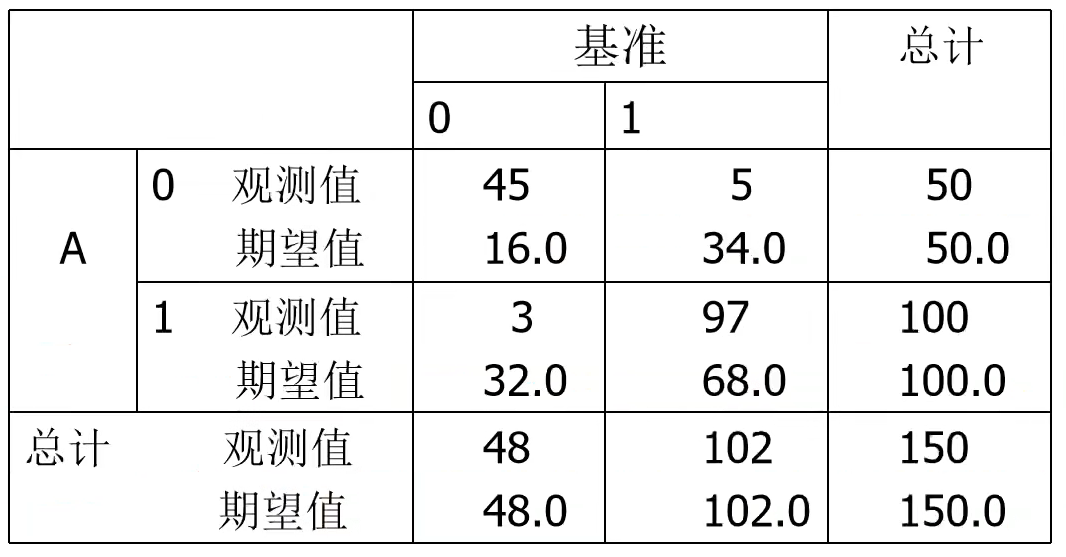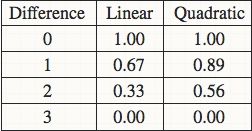一致性检验评价方法kappa
最近在做眼底图像的无监督分类,使用的数据集辣子kaggle的Diabetic Retinopathy,简称DR,中文称糖尿病型眼底疾病。
最后的评估方法是二次加权kappa。以前没接触过,网上也没有具体的介绍,在这里简单谈谈我的理解,如有错误欢迎指出。
简介
Kappa指数用来衡量两个模型对同一张图片进行判断时,判断结果一致的程度,结果范围从0~1,1表示评价完全相同,0表示评价完全相反。
一般用模型获得相同评价的数量与基于可能性的期望是否有差别来分析,当两个模型相同评价的数量和基于可能性期望的数量基本一样时,kappa的值就接近于1。
举个栗子,模型A和基准的kappa:

kappa = (p0-pe) / (n-pe)
其中,P0 = 对角线单元中观测值的总和;pe = 对角线单元中期望值的总和。
根据kappa的计算方法分为简单kappa(simple kappa)和加权kappa(weighted kappa),加权kappa又分为linear weighted kappa和quadratic weighted kappa。
weighted kappa
关于linear还是quadratic weighted kappa的选择,取决于你的数据集中不同class之间差异的意义。比如对于眼底图像识别的数据,class=0为健康,class=4为疾病晚期非常严重,所以对于把class=0预测成4的行为所造成的惩罚应该远远大于把class=0预测成class=1的行为,使用quadratic的话0->4所造成的惩罚就等于16倍的0->1的惩罚。如下图是一个四分类的两个计算方法的比较。

Python实现
参考:https://github.com/benhamner/Metrics/blob/master/Python/ml_metrics/quadratic_weighted_kappa.py
#! /usr/bin/env python2.7
import numpy as np
def confusion_matrix(rater_a, rater_b, min_rating=None, max_rating=None):
"""
Returns the confusion matrix between rater's ratings
"""
assert(len(rater_a) == len(rater_b))
if min_rating is None:
min_rating = min(rater_a + rater_b)
if max_rating is None:
max_rating = max(rater_a + rater_b)
num_ratings = int(max_rating - min_rating + 1)
conf_mat = [[0 for i in range(num_ratings)]
for j in range(num_ratings)]
for a, b in zip(rater_a, rater_b):
conf_mat[a - min_rating][b - min_rating] += 1
return conf_mat
def histogram(ratings, min_rating=None, max_rating=None):
"""
Returns the counts of each type of rating that a rater made
"""
if min_rating is None:
min_rating = min(ratings)
if max_rating is None:
max_rating = max(ratings)
num_ratings = int(max_rating - min_rating + 1)
hist_ratings = [0 for x in range(num_ratings)]
for r in ratings:
hist_ratings[r - min_rating] += 1
return hist_ratings
def quadratic_weighted_kappa(rater_a, rater_b, min_rating=None, max_rating=None):
"""
Calculates the quadratic weighted kappa
quadratic_weighted_kappa calculates the quadratic weighted kappa
value, which is a measure of inter-rater agreement between two raters
that provide discrete numeric ratings. Potential values range from -1
(representing complete disagreement) to 1 (representing complete
agreement). A kappa value of 0 is expected if all agreement is due to
chance.
quadratic_weighted_kappa(rater_a, rater_b), where rater_a and rater_b
each correspond to a list of integer ratings. These lists must have the
same length.
The ratings should be integers, and it is assumed that they contain
the complete range of possible ratings.
quadratic_weighted_kappa(X, min_rating, max_rating), where min_rating
is the minimum possible rating, and max_rating is the maximum possible
rating
"""
rater_a = np.array(rater_a, dtype=int)
rater_b = np.array(rater_b, dtype=int)
assert(len(rater_a) == len(rater_b))
if min_rating is None:
min_rating = min(min(rater_a), min(rater_b))
if max_rating is None:
max_rating = max(max(rater_a), max(rater_b))
conf_mat = confusion_matrix(rater_a, rater_b,
min_rating, max_rating)
num_ratings = len(conf_mat)
num_scored_items = float(len(rater_a))
hist_rater_a = histogram(rater_a, min_rating, max_rating)
hist_rater_b = histogram(rater_b, min_rating, max_rating)
numerator = 0.0
denominator = 0.0
for i in range(num_ratings):
for j in range(num_ratings):
expected_count = (hist_rater_a[i] * hist_rater_b[j]
/ num_scored_items)
d = pow(i - j, 2.0) / pow(num_ratings - 1, 2.0)
numerator += d * conf_mat[i][j] / num_scored_items
denominator += d * expected_count / num_scored_items
return 1.0 - numerator / denominator
def linear_weighted_kappa(rater_a, rater_b, min_rating=None, max_rating=None):
"""
Calculates the linear weighted kappa
linear_weighted_kappa calculates the linear weighted kappa
value, which is a measure of inter-rater agreement between two raters
that provide discrete numeric ratings. Potential values range from -1
(representing complete disagreement) to 1 (representing complete
agreement). A kappa value of 0 is expected if all agreement is due to
chance.
linear_weighted_kappa(rater_a, rater_b), where rater_a and rater_b
each correspond to a list of integer ratings. These lists must have the
same length.
The ratings should be integers, and it is assumed that they contain
the complete range of possible ratings.
linear_weighted_kappa(X, min_rating, max_rating), where min_rating
is the minimum possible rating, and max_rating is the maximum possible
rating
"""
assert(len(rater_a) == len(rater_b))
if min_rating is None:
min_rating = min(rater_a + rater_b)
if max_rating is None:
max_rating = max(rater_a + rater_b)
conf_mat = confusion_matrix(rater_a, rater_b,
min_rating, max_rating)
num_ratings = len(conf_mat)
num_scored_items = float(len(rater_a))
hist_rater_a = histogram(rater_a, min_rating, max_rating)
hist_rater_b = histogram(rater_b, min_rating, max_rating)
numerator = 0.0
denominator = 0.0
for i in range(num_ratings):
for j in range(num_ratings):
expected_count = (hist_rater_a[i] * hist_rater_b[j]
/ num_scored_items)
d = abs(i - j) / float(num_ratings - 1)
numerator += d * conf_mat[i][j] / num_scored_items
denominator += d * expected_count / num_scored_items
return 1.0 - numerator / denominator
def kappa(rater_a, rater_b, min_rating=None, max_rating=None):
"""
Calculates the kappa
kappa calculates the kappa
value, which is a measure of inter-rater agreement between two raters
that provide discrete numeric ratings. Potential values range from -1
(representing complete disagreement) to 1 (representing complete
agreement). A kappa value of 0 is expected if all agreement is due to
chance.
kappa(rater_a, rater_b), where rater_a and rater_b
each correspond to a list of integer ratings. These lists must have the
same length.
The ratings should be integers, and it is assumed that they contain
the complete range of possible ratings.
kappa(X, min_rating, max_rating), where min_rating
is the minimum possible rating, and max_rating is the maximum possible
rating
"""
assert(len(rater_a) == len(rater_b))
if min_rating is None:
min_rating = min(rater_a + rater_b)
if max_rating is None:
max_rating = max(rater_a + rater_b)
conf_mat = confusion_matrix(rater_a, rater_b,
min_rating, max_rating)
num_ratings = len(conf_mat)
num_scored_items = float(len(rater_a))
hist_rater_a = histogram(rater_a, min_rating, max_rating)
hist_rater_b = histogram(rater_b, min_rating, max_rating)
numerator = 0.0
denominator = 0.0
for i in range(num_ratings):
for j in range(num_ratings):
expected_count = (hist_rater_a[i] * hist_rater_b[j]
/ num_scored_items)
if i == j:
d = 0.0
else:
d = 1.0
numerator += d * conf_mat[i][j] / num_scored_items
denominator += d * expected_count / num_scored_items
return 1.0 - numerator / denominator
def mean_quadratic_weighted_kappa(kappas, weights=None):
"""
Calculates the mean of the quadratic
weighted kappas after applying Fisher's r-to-z transform, which is
approximately a variance-stabilizing transformation. This
transformation is undefined if one of the kappas is 1.0, so all kappa
values are capped in the range (-0.999, 0.999). The reverse
transformation is then applied before returning the result.
mean_quadratic_weighted_kappa(kappas), where kappas is a vector of
kappa values
mean_quadratic_weighted_kappa(kappas, weights), where weights is a vector
of weights that is the same size as kappas. Weights are applied in the
z-space
"""
kappas = np.array(kappas, dtype=float)
if weights is None:
weights = np.ones(np.shape(kappas))
else:
weights = weights / np.mean(weights)
# ensure that kappas are in the range [-.999, .999]
kappas = np.array([min(x, .999) for x in kappas])
kappas = np.array([max(x, -.999) for x in kappas])
z = 0.5 * np.log((1 + kappas) / (1 - kappas)) * weights
z = np.mean(z)
return (np.exp(2 * z) - 1) / (np.exp(2 * z) + 1)
def weighted_mean_quadratic_weighted_kappa(solution, submission):
predicted_score = submission[submission.columns[-1]].copy()
predicted_score.name = "predicted_score"
if predicted_score.index[0] == 0:
predicted_score = predicted_score[:len(solution)]
predicted_score.index = solution.index
combined = solution.join(predicted_score, how="left")
groups = combined.groupby(by="essay_set")
kappas = [quadratic_weighted_kappa(group[1]["essay_score"], group[1]["predicted_score"]) for group in groups]
weights = [group[1]["essay_weight"].irow(0) for group in groups]
return mean_quadratic_weighted_kappa(kappas, weights=weights)
一致性检验评价方法kappa的更多相关文章
- 多准则决策模型-TOPSIS评价方法-源码
? 1 2 3 4 5 6 7 8 9 10 11 12 13 14 15 16 17 18 19 20 21 22 23 24 25 26 27 28 29 30 31 32 33 34 35 36 ...
- 自动文档摘要评价方法:Edmundson,ROUGE
自动文档摘要评价方法大致分为两类: (1)内部评价方法(Intrinsic Methods):提供参考摘要,以参考摘要为基准评价系统摘要的质量.系统摘要与参考摘要越吻合, 质量越高. (2)外部评价方 ...
- 全参考视频质量评价方法(PSNR,SSIM)以及与MOS转换模型
转载处:http://blog.csdn.NET/leixiaohua1020/article/details/11694369 最常用的全参考视频质量评价方法有以下2种: PSNR(峰值信噪比):用 ...
- 图像质量评价方法PSNR+SSIM&&评估指标SROCC,PLCC
update:2018-04-07 今天发现ssim的计算里面有高斯模糊,为了快速计算,先对每个小块进行计算,然后计算所有块的平均值.可以参考源代码实现,而且代码实现有近似的在里面!matlab中中图 ...
- 机器学习评价方法 - Recall & Precision
刚开始看这方面论文的时候对于各种评价方法特别困惑,还总是记混,不完全统计下,备忘. 关于召回率和精确率,假设二分类问题,正样本为x,负样本为o: 准确率存在的问题是当正负样本数量不均衡的时候: 精心设 ...
- 视频质量评价方法:VQM
如何确定一个视频质量的好坏一直以来都是个棘手的问题.目前常用的方法就是通过人眼来直接观看,但是由于人眼的主观性及观看人员的单体差异性,对于同样的视频质量,不同的人的感受是不一样的.为此多个研究机构提出 ...
- 多标签图像分类任务的评价方法-mAP
http://blog.sina.com.cn/s/blog_9db078090102whzw.html 多标签图像分类(Multi-label Image Classification)任务中图片的 ...
- logistic regression评价方法
1.sensitivity,也叫recall,true positive rate,含义是预测为正向的case中对的(true positive)和所有事实为正向的case的比例. 2.specifi ...
- 【一致性检验指标】Kappa(cappa)系数
1 定义 百度百科的定义: 它是通过把所有地表真实分类中的像元总数(N)乘以混淆矩阵对角线(Xkk)的和,再减去某一类地表真实像元总数与被误分成该类像元总数之积对所有类别求和的结果,再除以总像元数的平 ...
随机推荐
- 原来VIM还可以这样玩
文章目录 配置文件vimrc vim 状态栏 状态栏配置内容 状态栏常用信息 显示状态栏 终端安全色 vimrc 配置文件 推荐 vi/vim命令大全 vim参阅 配置文件vimrc 在vim文件中执 ...
- docker为什么会出现
痛点 环境不同所引发的问题 一款产品从开发到上线,一般都会有开发环境,测试环境,运行环境. 如果有一个环境中某个软件或者依赖版本不同了,可能产品就会出现一些错误,甚至无法运行.比如开发人员在windo ...
- Python中读写文件三部曲
写入文件:要把第二个参数 'r' 改成 'w' ,表示write,即以写入的模式打开文件; 往文件中写入内容,使用write()函数. 例子如下:注意 'w' 写入模式会暴力清空掉原有文件,然后再写 ...
- embarrass的writeup
大家好,这次我要为大家带来都是攻防世界misc部分embarrass的writeup. 首先下载附件,是一个压缩包,解压后找到一个流量包.用wireshark打开,直接在搜索框中输入flag{ ...
- 强大的数据包处理程序scapy
实验目的 利用scapy工具构造arp.icmp数据包,发送到目标主机,根据应答包推测出目标系统存活情况 实验原理 Scapy是Python写的一个功能强大的交互式数据包处理程序,可用来发送.嗅探.解 ...
- [数分笔记]问题1.1 T1
题目:非负整数a,b使得为整数,求证这个整数必是某一整数的平方.(1988年第29届国际数学奥林匹克竞赛试题) 证明:设k=,k为非负整数 1°a=b k=2a²/(1+a²)=2-2/(1+a²) ...
- 现在的BI软件是不是很贵?
目前一个企业光有现在狭义的拖拉拽自助 BI 够用吗?那明显是不够的!那么企业应该需要什么样的BI系统? 一个很多企业真正需要的 BI 解决方案一般有一下几类: 1.数据呈现 这是最关键也最基本的功能, ...
- Hook(钩子技术)基本知识讲解,原理
一.什么是HOOK(钩子) API Windows消息传递机制,当在应用程序进行相关操作,例如点击鼠标.按下键盘,操作窗口等,操作系统能够感知这一事件,接着把此消息放到系统消息队列,然后到应用程序的 ...
- Map<String, String> 遍历的四种方法
Map<String, String> map = new HashMap<String, String>(); map.put("key1", " ...
- Linux实时查看日志的四种命令详解
转至:https://blog.csdn.net/qq_33223299/article/details/93773989 如何在Linux中实时查看日志文件的内容?那么有很多实用程序可以帮助用户在文 ...
